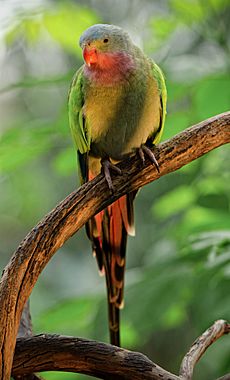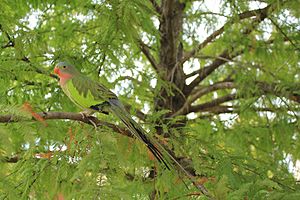Princess parrot facts for kids
Quick facts for kids Princess parrot |
|
|---|---|
 |
|
| Conservation status | |
| Scientific classification | |
| Genus: |
Polytelis
|
| Species: |
alexandrae
|
The princess parrot (Polytelis alexandrae) is a very colorful bird from Australia. It belongs to the parrot family. This parrot was named in 1863 to honor Princess Alexandra of Denmark. She later became the Queen of the United Kingdom.
People also call this bird by other names. These include the Queen Alexandra parrot, Alexandra's parakeet, and Princess of Wales parakeet. Sometimes it's called the rose-throated parakeet or spinifex parrot. Most of its feathers are green. It has a pink throat, a bluish head and back, and bright green shoulders.
Contents
About the Princess Parrot

The princess parrot is a medium-sized bird. It is usually between 34 and 46 centimeters (13 to 18 inches) long. It weighs about 110 to 120 grams (3.9 to 4.2 ounces). Its feathers are mostly green. It has a pink throat, a blue crown on its head, and bright green shoulders. The lower back is blue, and its tail is long and thin.
Male and female princess parrots look a bit different. Males have longer tail feathers and brighter colors. A male also has a coral-red beak, while a female's beak is not as bright. Her crown is also more grayish. Males have orange eyes (called an iris), but females have browner eyes. Adult male parrots also have a special long feather on each wing. This feather is called a 'spatula'.
Princess Parrot Behavior
This parrot species is nomadic. This means they travel around a lot. They arrive in small groups to have their babies, then they disappear again. They are one of Australia's least known parrots. This is because they are hard to find, even though they live across central Australia.
Princess parrots live in dry woodlands and scrub areas. They like places with spinifex grass, eucalypt trees, and acacia trees. They are unusual because they will sometimes "mob" predators. This means they gather in a group to chase away animals that might harm them. They eat seeds from grasses and shrubs.
Reproduction and Life Cycle
Female princess parrots lay four to six white eggs. The eggs hatch after about 19 days. The baby parrots, called chicks, leave the nest around 35 days after they hatch. These parrots are "opportunistic breeders." This means they choose to nest and have babies when there is plenty of food available. They build their nests inside hollows in eucalypt or desert oak trees.
Keeping Princess Parrots as Pets

Princess parrots can make loud calls. They are thought to live for as long as 30 years. If cared for well, they can bond with more than one person in a family. These birds can learn to copy some sounds and even "talk" a little. Many aviculturists (people who raise birds) and pet owners like them. This is because of their beautiful looks and friendly personality.
Their diet should include seeds and grasses that have seeds. It's important to keep their food bowls clean. Rats or mice can make the food dirty and make the birds sick. It's best to feed them on a ceramic pot with a bowl on top. The bowl should not be wider than the pot.
There are three common color changes, called mutations, in these parrots. These colors are Lutino (yellow), Blue, and Albino (a mix of Blue and Lutino). The natural color of the wild parrot is green. There are two types of blue parrots. One has blue wings, and the other has bright blue wings and a bright blue head.
See also
 In Spanish: Perico princesa para niños
In Spanish: Perico princesa para niños




